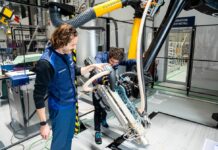Mitsubishi Electric Corporation contributes to manufacturing in a decarbonized era with a machine that melts welding wire with a laser beam to create high-quality 3D structures.
Various companies of Mitsubishi Group are involved in different 3D printing segments of the industry. In addition to MHI Machine Tool that delivers metal 3D printing solutions, the market will now see OEM Mitsubishi Electric Corporation further involves in the machine segment. So far, the company has been working with other hardware specialists such as AMT to enhance post-processing solutions in the industry.
Interestingly, the Tokyo-based electronics manufacturer had announced the development of precision metal printing with “dot forming” Direct Energy Deposition (DED). Set to increase productivity by manufacturing near-finished parts, the machine’s commercialization would have begun last year.
Today, it launches two models of the “AZ600” wire-laser metal 3D printer. The 3D printers – AZ600-F20 and AZ600-F40 – melt welding wire with a laser beam to create high-quality 3D structures. The AZ600 is a combination of digital additive-manufacturing technology and simultaneous 5-axis spatial control that operates in a coordinated control of machining conditions to deliver stable, high-quality 3D printing.
Furthermore, it contributes to manufacturing in a decarbonized era by reducing energy consumption, saves resources by shortening of processing time and using highly efficient production methods such as ‘near-net-shape’, and supports the build-up of repairs for the maintenance of specialist parts for automobiles, ships and aircraft. Additionally, a new contract printing service utilizing these printers will help the adoption of additive manufacturing by offering product design consultation, prototyping and general advice about the application of 3D metal printing.
In recent years, the growing need to reduce CO2 emissions in the metalworking manufacturing industry has stimulated an increase in demand for more efficient metalworking methods that reduce energy consumption and conserve finite natural resources. In particular, demand is expected to grow for metal 3D printers, which create objects from 3D shape data. This has the advantages of significantly shortening the conventional manufacturing process, reducing waste materials in the manufacturing process, and improving design flexibility by making it easier to integrate multiple parts and reduce weight. On the other hand, metal 3D printers that use powder-based feedstock have issues with material management, workability and safety, and a new additive manufacturing process has been required.
Remember, you can post job opportunities in the AM Industry on 3D ADEPT Media free of charge or look for a job via our job board. Make sure to follow us on our social networks and subscribe to our weekly newsletter : Facebook, Twitter, LinkedIn & Instagram ! If you want to be featured in the next issue of our digital magazine or if you hear a story that needs to be heard, make sure to send it to contact@3dadept.com






